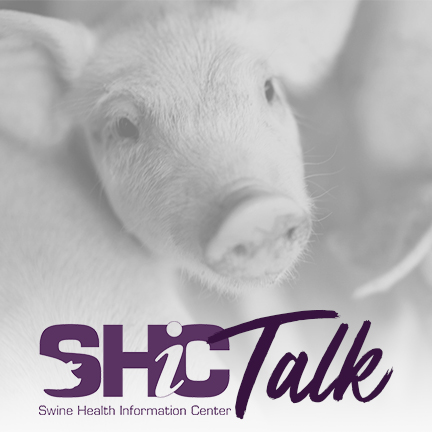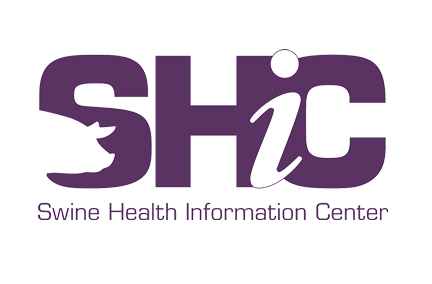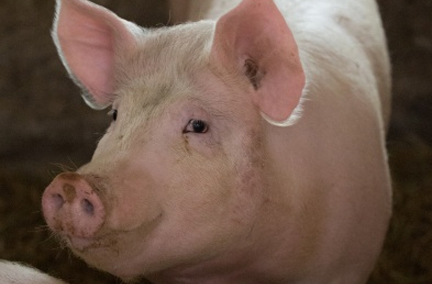
SHIC, launched in 2015 with Pork Checkoff funding, continues to focus efforts on prevention, preparedness, and response to novel and emerging swine disease for the benefit of US swine health. As a conduit of information and research, SHIC encourages sharing of its publications and research. Forward, reprint, and quote SHIC material freely. SHIC is funded by America’s pork producers to fulfill its mission to protect and enhance the health of the US swine herd. For more information, visit http://www.swinehealth.org or contact Dr. Sundberg at [email protected].

On July 28, 2021, the Ministry of Agriculture of the Dominican Republic confirmed the presence of African swine fever (ASF) after learning the results of tests on 389 samples collected from pigs raised on farms and in backyards sent to the USDA – Foreign Animal Disease Diagnostic Laboratory (Plum Island) through an existing cooperative surveillance program.
The arrival of ASF in the Dominican Republic means the disease has leapt into the Americas for the first time in 40 years. Back then, the Dominican Republic dealt with the disease from 1978 to 1980, with 374 outbreaks reported throughout that period, representing an impact of 192,473 culled pigs.
“This is a small population compared to the total population of pigs in the country, which is estimated between 1.5 million and 1.8 million pigs,” authorities stated.
Early response
The Dominican government has assured that its Minister of Agriculture has already activated the National Emergency Committee for Exotic Diseases of Domestic Animals to ensure all institutions in the agricultural sector operate in a coordinated way to guarantee the national production of pigs.
Some of the immediate actions in place include:
USDA response
USDA’s Animal and Plant Health Inspection Service (APHIS) has numerous interlocking safeguards in place to prevent ASF from entering the United States. Pork and pork products from the Dominican Republic are currently prohibited entry as a result of existing classical swine fever (CSF) restrictions.
Additionally, the Department of Homeland Security’s Customs and Border Protection (CBP) is increasing inspections of flights from the Dominican Republic to ensure travelers do not bring prohibited products to the United States. CBP will also be ensuring that garbage from these airplanes is properly disposed of to prevent the transmission of ASF.
USDA is committed to assisting the Dominican Republic in dealing with ASF, is offering continued testing support, and will consult with them on additional steps or actions to support response and mitigation measures. USDA will also provide similar help to Haiti, which borders the Dominican Republic and is at high risk for ASF detections.
USDA has urged the Department of Homeland Security to increase surveillance of humans and their baggage from the Dominican Republic, especially by the beagle patrol, to have even more scrutiny for illegal movement of meat and pork products.
Regional concern
In the last few days, local news agencies have reported an increase in the mortality of pigs in Ansa a Pitres, a small Haitian town near the border with the Dominican Republic.
Dominican authorities have banned the commercialization of swine meat in the border region after receiving some reports from Dominican military forces at the border regarding the events developing in the neighboring country.
USDA has alerted Puerto Rico and will have an increased presence and surveillance for Puerto Rico. Concerns with illegal boat movements from D.R. to other Caribbean countries are a concern, also.
AMERICA
https://www.aphis.usda.gov/aphis/newsroom/news/sa_by_date/sa-2021/asf-confirm
https://www.youtube.com/watch?v=4ATpiC_Iiyc
The GSDMR team compiles information drawn from multiple national (Ministries of Agriculture or Livestock, Local governments and international sources (FAO, OIE, DEFRA, EC, etc.), as well as peer-reviewed scientific articles. The team makes every effort to ensure but does not guarantee, accuracy, completeness, or authenticity of the information. The designation employed and the presentation of material on maps and graphics do not imply the expression of any opinion whatsoever on the part of the GSDMR team concerning the legal or constitutional status of any country, territory, or sea area, or concerning the delimitation of frontiers.
Any inquiries regarding this publication should be sent to us at [email protected]

The Swine Health Information Center (SHIC) invites you to learn more about morbillivirus, recently diagnosed in piglets in Mexico, by listening to SHIC Talk. Drs. Bailey Arruda and Ganwu Li share their insights with SHIC Talk host Barbara Campbell Determan in this episode.

Porcine reproductive and respiratory syndrome virus (PRRSV) 1-4-4 1C appeared in southern Minnesota and northern Iowa in late 2020. Dramatic clinical signs on farms raised concern and the Swine Health Information Center (SHIC), with co-sponsor American Association of Swine Veterinarians, offered a webinar on PRRSV 1-4-4 1C on February 4, 2021. A second wave of outbreaks in April and May 2021 in a wider geography with positive cases in upper Midwest states keeps this virus at the forefront. A second webinar, PRRS 1-4-4 Incidence and Response, took place July 20, 2021, featuring discussion on SHIC Rapid Response Teams’ investigations into possible pathways of entry of the virus plus updates on incidence and geographic distribution.
July webinar presenters included Dr. Giovani Trevisan, Iowa State University (ISU)/Swine Disease Reporting System (SDRS), Dr. Mariana Kikuti, University of Minnesota/Morrison Swine Health Monitoring Project (MSHMP), Dr. Paul Yeske of the Swine Vet Center, St. Peter, Minnesota, and Dr. Derald Holtkamp, ISU Veterinary Diagnostic and Production Animal Medicine. MSHMP is a SHIC-funded program focused on communication of disease occurrence. The webinar was conducted by the ISU Swine Medicine Education Center.
While 1-4-4 is not a new strain, on-farm experience with this new lineage 1C (L1C) variant has shown it results in higher farrow-to-finish mortality, abortions, mummies, and slower growth in finishing pigs compared to other PRRSV strains. Dr. Trevisan said information gathered from upper Midwest veterinary diagnostic labs shows PRRSV lineage detection over time is very dynamic with the L1C variant already becoming the fourth most detected. Data submitted to the Swine Disease Reporting System (reported by SHIC in the monthly Domestic Swine Disease Monitoring Report) shows the L1C variant is most frequently detected in the wean-to-market category in Minnesota and Iowa.
Dr. Trevisan said diversity is inherent to PRRSV and this remains true for the L1C variant which is evolving and forming different groups. While it remains most frequently detected in Iowa and Minnesota, at least seven other states have reported the L1C variant is present. More epidemiological work is needed for better understanding of this variant.
Dr. Kikuti presented information from MSHMP showing this variant is unusually similar at the ORF5 level between different sites. She also detailed their case definition saying sequences that were at least 98% similar to any other case sequence were included. As of June 30, 2021, a cluster of 259 sequences were reported. There were 227 sites affected, including 64 breeding herds, 126 growing pig farms, and 37 without information defining their type. But one concern Dr. Kikuti mentioned was lack of standardized nomenclature for whole genome sequences which assures the same case definition is used throughout the industry.
Dr. Yeske has seen the variant’s effects first hand as a practitioner. Clinical observations include abortions which continue to be the hallmark of the variant though the frequency was less in the spring outbreak than last fall. Mortality rates were about the same with both outbreaks. In the farrowing herd, stillborns and mummies were common. Preweaning mortality was as high as 100% for a few weeks this spring. They also noticed piglet quality deteriorating rapidly, and postweaning there was higher than normal mortality.
The SHIC Rapid Response Team outbreak investigation took place on two farms that broke with the variant in the spring. Dr. Holtkamp set up the Team’s work with the farms and emphasized the goal is not assigning blame to anyone on either farm or the system it is part of, rather, to understand weaknesses in biosecurity and then develop plans for improvement.
The Rapid Response Team hazard analysis uses available epidemiological information including sequencing information as well as timing and location of the first clinical signs of the variant. The analysis looks for where the farm is vulnerable. With the high area incidence and so many potential factors at play, Dr. Holtkamp described the process as conducting a murder investigation in the middle of a gang fight, meaning there are an extraordinary number of suspects.
A review of production activities launches the investigation, looking at people, equipment, tools, supplies, animals, locations, timing of activities, and procedures including the who, what, where, and how of each. The Rapid Response Team’s form used for the investigation is available on the SHIC website.
Both farms being reviewed were commercial farrow-to-wean farms. On farm one, the first clinical signs were noted on May 9, 2021, where the first signs of the outbreak were scouring and rough hair coats on piglets in farrowing rooms. On farm two, the first clinical signs were seen on May 29, 2021, where sows were off feed in part of the gestation barn.
Four weeks of each farm’s records were analyzed. On farm one, there were 575 risk events noted. On farm two, there were 580 risk events. The Rapid Response Team rated employee entry and removal of weaned pigs as the highest risk factors on farm one. On farm two, removal of cull sows was the highest risk event. The Team noted employee transfer between farms in the system was a concern as well.
Because PRRSV 1-4-4 1C is more virulent and highly contagious, Dr. Holtkamp remarked any lapse in biosecurity could be an entry point onto a farm. Dr. Yeske observed the magnitude of the outbreak waves increased from the fall of 2020 to the spring of 2021, which creates concerns for a wave to occur again this fall. Both Drs. Yeske and Holtkamp are encouraging review of biosecurity plans to identify the potential areas of entry on farms.

The Swine Health Information Center (SHIC) Swine Disease Fact Sheet Library continues to be updated. This process, part of SHIC’s mission to protect the health of the US swine herd, provides guidance and resources for producers, practitioners, and diagnosticians who are on the front lines of swine health concerns. Recently updated fact sheets address porcine sapelovirus, high path porcine reproductive and respiratory virus, Ebola virus, porcine teschovirus, and Japanese encephalitis virus. Each fact sheet begins with a summary followed by a complete literature review addressing importance, public health, infection in swine, treatment, cleaning and disinfection, prevention and control, transmission, pathogenesis, diagnosis, epidemiology, etiology, history in swine, immunity, and gaps in preparedness.
Porcine sapelovirus (PSV), an enteric picornavirus of swine, has been detected in healthy pigs as well as pigs with diarrhea, neurological, reproductive, and respiratory disease. The updated SHIC Fact Sheet on PSV includes new information on prevalence and diagnostics, as well a description of an outbreak of PSV-associated polioencephalomyelitis in the US.
Updated fact sheets on high path porcine reproductive and respiratory virus (HP-PRRSV) and Ebola virus feature revised taxonomy and epidemiology sections. While to date Chinese HP-PRRSV variants have not been detected in the United States, there is ongoing concern about transboundary spread. HP-PRRSV causes clinical disease and death in all ages, including adult pigs and pregnant sows. “Ebola virus” refers specifically to the species Zaire Ebola virus. Clinical illness due to Ebola virus has not been reported in pigs. However, serosurveys indicate pigs in some regions have been exposed to Ebola virus. The prevalence of Reston virus in pigs is unknown.
Porcine teschovirus (PTV) is an enteric picornavirus of swine. Why some PTVs cause polioencephalomyelitis and others circulate inapparently is not known. In the United States, diagnostic laboratory submissions with a history of posterior paresis seem to be increasing in pigs from a wide age range.
Japanese encephalitis virus (JEV) is a zoonotic arbovirus that is endemic in much of Asia and the western Pacific region. Pigs are an amplifying host of JEV while most other susceptible species are dead-end hosts. Japanese encephalitis (JE) is currently a foreign animal disease, but its emergence in the United States is a concern due to the presence of competent mosquito vectors and susceptible hosts.

Discovered in 2001, porcine parvovirus 2 (PPV2) is prevalent in swine worldwide. A recently completed Swine Health Information Center (SHIC)-funded research project on PPV2 confirmed the high prevalence of PPV2 in diseased pigs and provided insight into its significance in porcine respiratory disease complex (PRDC). Results supported PPV2 as one of the primary viral pathogens in the natural development of PRDC, particularly in weaned to finishing pigs.
Identifying high levels of PPV2 in the lung of a pig with pneumonia led researchers to seek SHIC funding so this investigation into its role in respiratory disease could begin. In the final research report, researchers said PPV2 was detected in 39% of lungs submitted for routine diagnostic testing. There was a significant positive correlation between PPV2 viral load and pig age. Histologically, PPV2 was mainly detected in alveolar macrophages in 28% of lungs with interstitial pneumonia, with PPV2 viral load tending to correlate with the number of macrophages in the lungs. While co-infections with PPV2 and established swine respiratory pathogens influenza A virus and porcine reproductive and respiratory syndrome virus (PRRSV) were commonly detected, assessment of viral loading and tissue locations showed no obvious association between PPV2 and other viral pathogens. Relatedly, in a third of PPV2 positive lungs analyzed by metagenomic sequencing, no other pathogens were identified.

The Swine Health Information Center (SHIC) monitors emerging swine disease threats, engaging experts on preparedness, response, and possible actions needed on behalf of the US pork industry. Recently, SHIC inquired with experts regarding a novel rotavirus affecting foals in Kentucky this spring. After consideration, those experts, Drs. Feng Li, University of Kentucky (UK) Gluck Equine Research Center, along with swine experts Albert Rovira, University of Minnesota, Ben Hause, South Dakota State University, and Eric Burrough, Iowa State University, conferred with SHIC and determined there was no need for action as the virus was not a threat to pork production.
“The consensus of the group was that equine rotavirus B was genetically more similar to ruminant as opposed to swine rotavirus B,” Dr. Hause stated. Ruminant genotypes of rotavirus B are found in goats and cattle as opposed to pigs. “We considered the potential for it to transmit to pigs however there was no reason for us to suspect this was likely at this time,” he remarked.
“It’s important SHIC has its ears to the ground, listening for anything emerging in other livestock species. It was right to ask the question. We all have informed opinions but none of us know for sure – we’re ranking risks here. In this case, several diagnosticians looked at it and said while it’s something to keep our eyes on, the threat doesn’t appear to be imminent for swine so there’s no need for further action at this time,” Dr. Hause concluded.
SHIC’s interest in the novel rotavirus was piqued when reports on extensive and evolving rotavirus B outbreaks in central Kentucky this spring surfaced. In an article on response to the outbreaks from the UK Gluck Equine Research Center, it was said farmers and practitioners noticed increases in diarrhea incidence in foals aged 2- to 7-days old. Investigation by the Gluck Center, as well as the UK Veterinary Diagnostic Lab (UKVDL), determined a novel rotavirus was the cause. Current diagnostic tests were unable to detect the pathogen causing diarrhea in very young foals affected, however, the UKVDL has subsequently developed a real-time PCR assay able to detect rotavirus B which was determined to be the cause of these new cases.
SHIC notes rotavirus B is more likely to jump to cattle than pigs, a primary reason to continue to watch its prevalence but without action in the swine industry. Of neonatal diarrhea cases coming to VDLs, over 90% will have some evidence of rotavirus, regardless of the actual cause of the disease. While the A-B-C rotavirus PCR does not pick up this equine virus, next generation sequencing and other tools are available now at reasonable cost making it more likely a new rotavirus strain will be quickly identified than it had been previously. These diagnostic steps and processes are followed by VDLs so rotaviruses are investigated and the process reliable for detection and diagnosis.
As the world deals with the COVID-19 pandemic, SHIC continues to focus efforts on prevention, preparedness, and response to novel
and emerging swine disease for the benefit of US swine health.

This month’s Domestic Swine Disease Monitoring Report shows a moderate decrease on the overall PRRS virus detection. However, detection of the PRRSV RFLP 1-4-4 L1C variant strain continues to be very active in the midwestern region, especially in the wean-to-market age category. A new tool to compare RFLP vs. lineage detections has been launched on the SDRS project website (www.fieldepi.org/SDRS). A moderate decrease in detection of PDCoV and PEDV was observed in June. In the podcast, SDRS hosts talk with Dr. Montserat Torremorell about her experience on surveillance of Influenza A, her thoughts on the PRRSV RFLP 1-4-4 L1C variant strain epidemic, and how to intervene to improve animal health.

In the Global Swine Disease Monitoring Report, read about an African swine fever (ASF) zoning agreement between Canada and Singapore. The two nations have agreed to allow for the safe trade of swine products. The 16th country in Asia has their first ASF outbreak as Bhutan reported a case of the disease to the OIE in early June. Also, information on the European Food Safety Authority’s panel’s risk assessment regarding ASF spread through outdoor pig farms is shared.
Copyright 2024 | Swinehealth.org | Website by Heartland Marketing Group